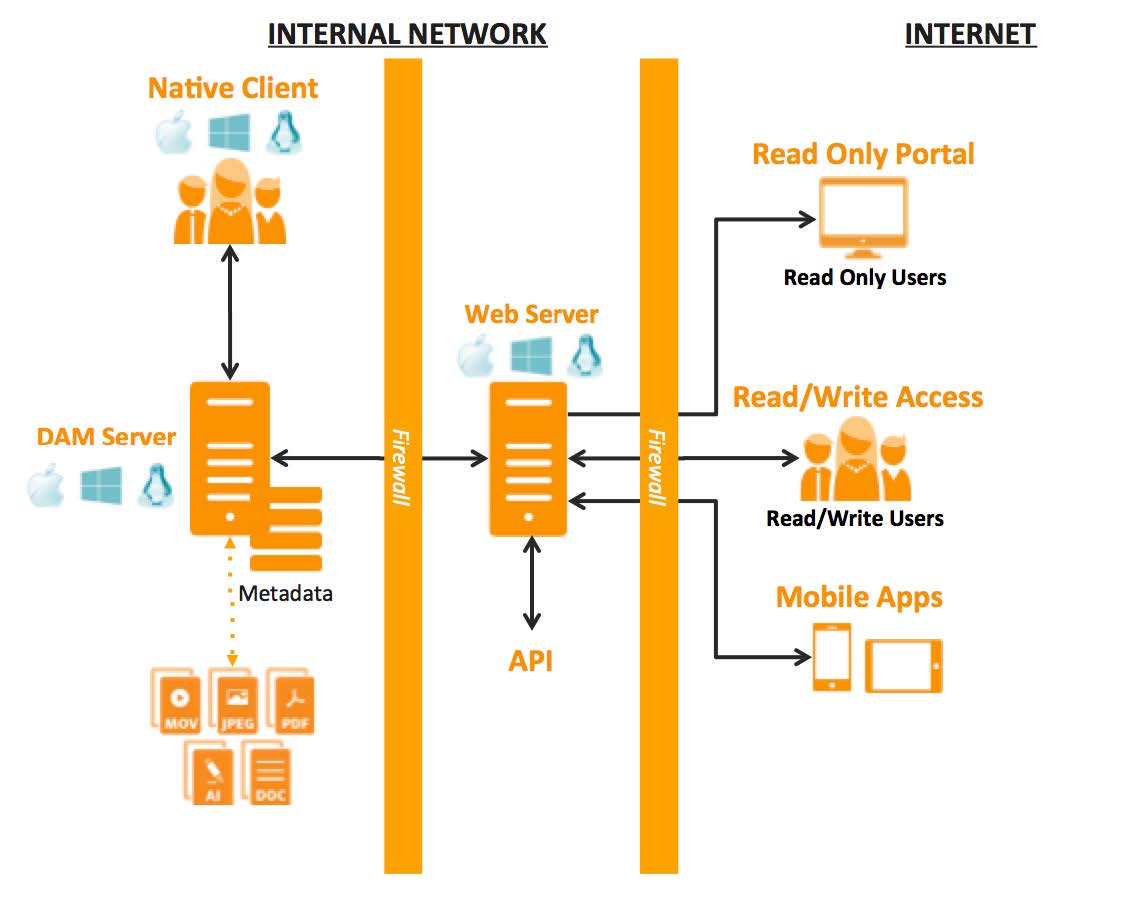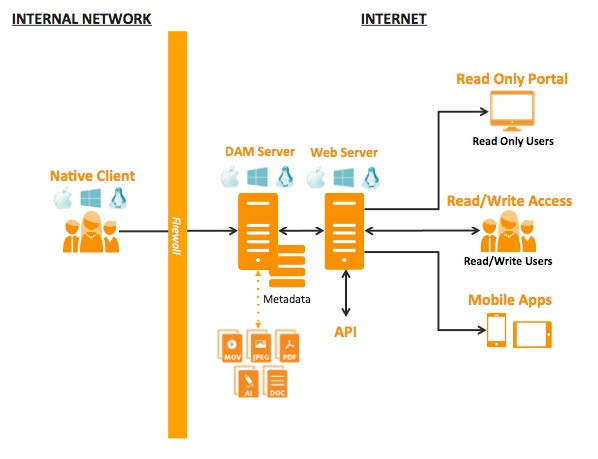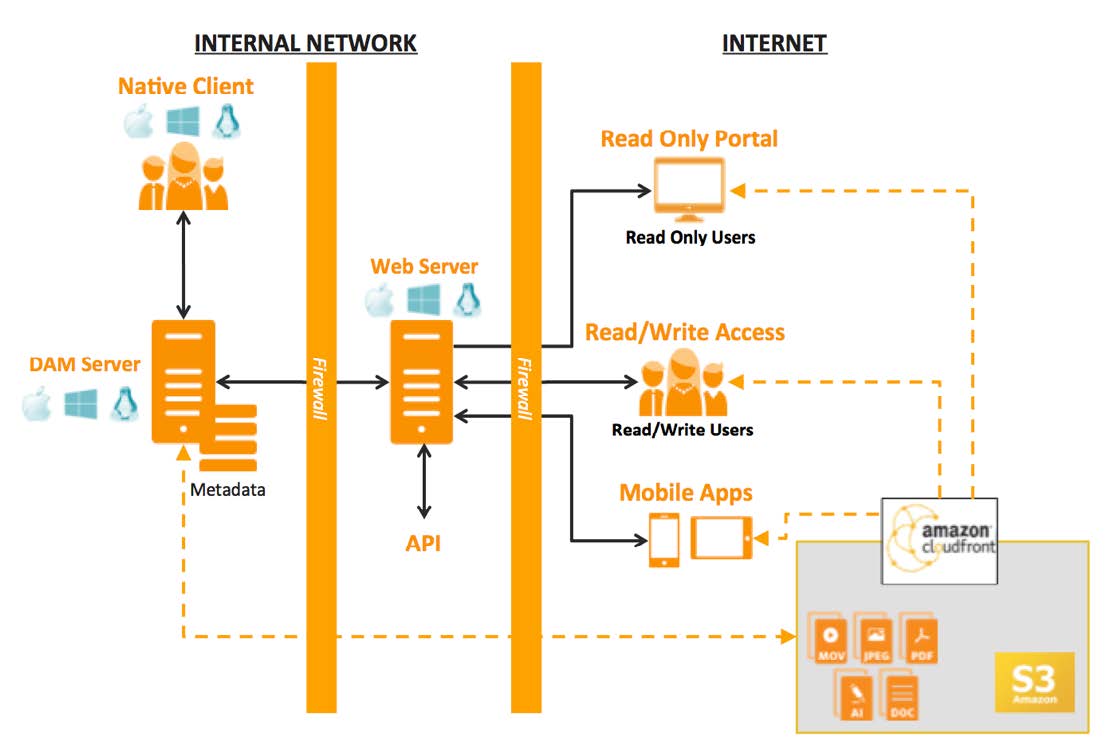DAM Deployment Options
December 4, 2015 •Antra Silova

Choosing how you want to deploy your DAM solution can be a vital decision on the path to success. Whereas many other applications are deployed based upon current organisational preference, with DAM there are more factors to consider. DAM is all about making content available to the right people, in the right format, in the right amount of time. Picking a suitable deployment strategy is often as important.
The topic of DAM deployment options can be very large – in this post we want to limit our focus to consideration of a dedicated DAM solution. As such, cloud SaaS DAM is not within our scope here.
The content in this post come from a range of sources. We’d like to acknowledge Benedikt Marck’s presentation at the Canto DAM Summit and that of Phil Meyer of Microsoft at the recent Axelera Briefing Breakfast, as well as the input from DataBasics Professional and Technical Services teams who are engaged on a day to day basis delivering DAM solutions in a range of environments.
One of the feature presentations at the 2015 Canto DAM Summit was Benedikt Marck’s talk on DAM deployment options – a topic of increasing importance as business and governments consider moving applications, infrastructure and or/or services to the cloud and “going digital” with their assets. Benedikt is Lead Project Manager at Canto and has worked with around 50 different customers on a range of small and large projects.
At DataBasics, our Professional and Technical Service teams have worked with a large number of customers on DAM projects in our region so we were especially interested in the changing landscape with regard to the three deployment scenarios now available: on-premise, cloud and hybrid.
In this article, we hope to shed more light on the differences between each option and the best choice to make when considering implementing or re-developing your digital asset management solution. Let’s look at them one at a time.
1. DAM on-premise
Historically, most Cumulus Digital asset management projects have been undertaken as on-premise deployments and this is often still the preferred way to go. DAM on-premise means having a local server managed by the organisation’s IT team, with all files and metadata saved internally and available over the LAN or WAN to content managers and consumers.
On-premise DAM

Diagram courtesy of Canto
The focus has largely been the creation of assets – working with Adobe products like InDesign and Microsoft’s Powerpoint for images, layouts and presentations.
It provides the ability for asset version control, privacy and copyright management and it may be easily interfaced with other existing infrastructure systems. Users can be authenticated via the internal AD network and backup/recovery regimes can be strictly managed by IT. And all available with a single one-off price.
| PROS | CONS |
| LAN speeds for internal access | Limited bandwidth for external access |
| Interfaces to other systems | Reliance on internal IT to manage |
| AD integration | |
| High internal costs for infrastructure and management of solution | |
| Barriers for external party to help manage solution |
Disadvantages? There are a few...
• the speed of LAN/WAN network connections for users may become an issue – especially if multiple offices in different locations globally are trying to access
• the ability of IT to manage what is essentially a business application may prove challenging.
2. DAM in the cloud – public or private
The new push has been to have everything – server, files and metadata – externally hosted in a cloud. All levels of government in Australia and our region now have a digital agenda to look at cloud first when considering services for their customers – and big business is not far behind, if not leading the way.
Cloud DAM

| Diagram courtesy of Canto |
The focus now is on publishing – putting those valuable digital assets to use by expanding distribution and delivery channels. With a cloud subscription comes managed services which means no IT department is required.
Managed services provided by the vendor or hoster offers peace of mind when it comes to ensuring 99.9% uptime as well as the provision of updates and upgrades to ensure the DAM solution is in optimal condition. Minimal IT involvement means internal resources are able to concentrate on their core work.
| PROS | CONS |
| Great for distributed network of users | If assets are very large, e.g. regular asset size in excess of 2-3 GB, network speed to upload content becomes an issue. This can be overcome. |
| Great for external access – i.e. focus on delivering content | |
| Does not rely on internal IT | Includes regular external costs for hosting |
| Is a very business orientated solution and maintains focus on the business needs |
Disadvantages? There are a few...
• privacy and security are rated the two primary reasons for being nervous about putting everything in the cloud – closely followed by disaster recovery
• a monthly subscription service may mean no access to data if the subscription lapses – and storage/bandwidth costs may rise so there is no budgetary certainty.
3. Hybrid cloud DAM
This seems to be the area where there is the most confusion – but also where there is the most growth. Hybrid cloud seems to offer the best of both worlds – retention of metadata and control of access locally, but distribution and delivery of assets for internal and external users regardless of location and with greater speed and efficiency.
Hybrid DAM

Diagram courtesy of Canto
Managed services provided by the vendor or hoster offers peace of mind when it comes to ensuring 99.9% uptime as well as the provision of updates and upgrades to ensure the DAM solution is in optimal condition.
| PROS | CONS |
| Maintains local access speeds for those within LAN | Will incur fees for both internal IT and hosting |
| Could be implemented with CDN for global access at high quality | Requires additional planning and budget to support a more complex solution by design |
| Is to a large extent the best of both on-premise and cloud environments |
Minimal IT involvement means internal resources are able to concentrate on their core work. By including Managed Services in your DAM strategy you can take advantage of a fully automated, self-service model with a service-oriented team approach.
Disadvantages? Not so many…
• choosing the asset collections you want to be publicly available versus those better kept in-house can be a challenge
• its limitations are probably the costs which will be similar to On Premise with additional monthly fees on top of the initial license cost.
Summary
According to Gartner(1), nearly half of large enterprises will have hybrid cloud deployments by the end of 2017. IT budget allocations in 2015 analysed by 451 Research(2) indicated over 60% were for hybrid and public cloud services whereas less than 40% was on premise in owned data centres.
The key takeaways from Benedikt’s presentation and our own research is that digital asset management is no longer a standalone single purpose product, but rather part of an integrated enterprise network of systems. As such, it needs to be incorporated into the overall business strategy to maximise the benefits. This means adapting to the model of a business-led solution rather than simply a software or IT solution. Organisations need to embrace the move from strictly on-premise or public cloud implementation to a hybrid cloud solution.
References
1. Gartner Inc. 2013 Press Release
2. 451 Research 2014. Hosting and Cloud Study 2014 Hosting and Cloud Go Mainstream (pdf)
For more information please contact DataBasics on 1300 886 238 (+617 3733 1510) or email info@databasics.com.au


